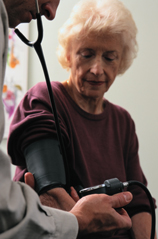Talking points on palliative care address public, patients
Experts decry “death panels” as a step backward for the public perception of palliative care. Clarifying its scope would help the profession move forward, according to speakers at a recent conference.
You don't have to be an expert in palliative care to know that the specialty has been going through a rough patch, publicity-wise.
But for experts, who gathered in Philadelphia in March for the first-ever National Palliative Care Summit, the public flurry over “death panels” has been particularly troubling. “It's dangerous,” said Diane E. Meier, FACP, professor of geriatrics at Mount Sinai and director of the Center to Advance Palliative Care. “It's a very politically effective weapon even though everyone on both sides knows that it's absurd.”
Speakers at the summit discussed strategies for changing and improving Americans' perceptions of palliative care. Talking about palliative care in new ways could increase understanding of the field—and its potential benefits—not only for politicians and the general public, but also hospital administrators and the patients in need of palliative care, experts said.
Talking to the public
Efforts to make the public look favorably on palliative care should start by clarifying what the specialty actually does, according to R. Sean Morrison, MD, a professor of geriatrics at Mount Sinai and director of the National Palliative Care Research Center.
“Palliative care is too often confused with end-of-life care and hospice in the minds of the public, professionals and policymakers,” he said. “Palliative care is about improving quality of life and matching treatment to goals in the setting of serious or life-threatening illness.” Many of the patients who could benefit from palliative care are not imminently dying, Dr. Morrison noted. But the association of palliative care with death brings forth people's innate discomfort with their own mortality.
If that discomfort could be avoided, patients might be more likely to use and benefit from palliative care, and some advances for the field—Medicare training slots for palliative care specialists and Joint Commission accreditation, for example—could potentially earn public support and funding.
“I think the public deserves that by 2020 all families who are facing serious or life-threatening illness will know to request palliative care,” Dr. Morrison said.
Previous efforts to garner public support for palliative care have tried to change attitudes about the end of life. It should not be surprising that they failed, said Dr. Morrison, who cited Tolstoy's writing about death nearly a century ago. “Death denial is still there. I'm not sure what makes us think that we are going to change that fundamental belief,” he said.
The alternative to changing beliefs is changing terminology, he explained. He proposed a social marketing campaign to drive public interest in palliative care as a solution. Another speaker, Kavita K. Patel, MD, MS, described recent efforts to garner political support for palliative care during health care reform negotiations. “Pain care management seems to be this term of art that encompasses palliative care without making people think of death panels,” said Dr. Patel, who is co-chair of the Bipartisan Policy Center's Health Care Workforce Consortium.
Some hospitals have already made the switch to more artful synonyms for palliative care. Oncologist Susan Urba, MD, spoke at the summit about the University of Michigan Comprehensive Cancer Center's “Symptom Management and Supportive Care” program.
“We used to be the palliative care clinic,” Dr. Urba explained. “A lot of it's semantics, but if it keeps patients away, we have to find the right words to bring them back.”
Talking to patients
Finding the right words to communicate with patients about palliative care is generally a tricky business. Clinical psychologist Joseph Greer, PhD, has had some recent success with this task. He was a co-author of a study, published in the New England Journal of Medicine in August 2010, which found that lung cancer patients who were randomized to receive palliative care consultations had less depression and longer survival than control patients.
The initiation of the palliative care consults was challenging, he said, describing one patient's attitude about their first meeting: “I'm not sure why we're meeting and what we're supposed to be talking about.” Physicians can sometimes be equally uncertain about the encounters, Dr. Greer added.
The trial, which also surveyed the content of the consultations, found that symptom management was often a place to start. “That is really a way in,” said Dr. Greer. “You want to make them understand your goal is to help them live as long as possible, as well as possible. ‘Let me see what I can do to help you feel a bit better today.’ You don't jump into conversation about code status; you don't jump into conversation about hospice.”
Still, at some point, the code status conversation needs to take place, and frequently that happens later in the process than would be ideal, according to Carol Chou, ACP Member, a clinical assistant professor of medicine at the University of Pennsylvania. “All too often it's a hospital admission that is the first time the subject is broached,” she said.
Broaching the subject at admission can make the conversation more awkward for both patients and physicians. “They [physicians] feel pressure to get a patient to commit to a particular code status. They admit to me that they feel like they are trying to force patients to a decision,” said Dr. Chou.
It doesn't help that this conversation is often conducted by a hospitalist who has never talked to the patient before, or, in some cases, a trainee who has little experience talking about the subject at all, said Amy Tsou, MD, also from the University of Pennsylvania.
“It's telling that when a need for these conversations arises, this task is often delegated to residents, interns and even medical students.” She suggested that, in addition to focusing more training on palliative care conversations, inpatient physicians make an effort to include outpatient physicians whenever possible.
Her colleague Katrina Armstrong, FACP, chief of general internal medicine at Penn, described a system in which a primary care physician participates in the conversation by video conferencing from his office to a computer on a cart. “They will call him up on the laptop and wheel him into the room,” she said.
Whichever physician handles the conversation, he or she should try to accomplish it with as many open-ended questions as possible, said Dr. Chou, who offered “What's important to you?” “Can you tell me what your understanding of your disease is?” and “How are you coping with this?” as examples. Physicians also shouldn't expect to get a patient to make these big decisions in a single conversation, Dr. Chou said. Instead, she sometimes asks patients, “May I call you tomorrow and we can readdress this issue?”





